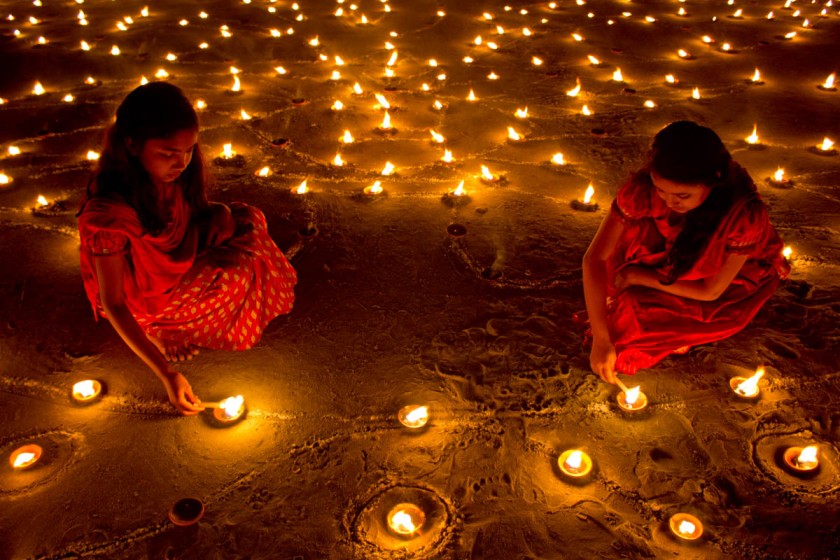
Diwali is an important festival celebrated by millions of people worldwide. From an astrological viewpoint, Diwali signifies the victory of light over darkness and good over evil. Diwali connects with various astrological beliefs, and people believe that during this auspicious time, Goddess Lakshmi showers her blessings upon her devotees, bringing wealth and prosperity to their homes. Let’s delve deeper into the significance of Diwali for 2023 and explore the various rituals and customs associated with this festival.
Also Read: When Is Janmashtami 2023? Know The Benefits & Significance Of This Day
Diwali, the festival of lights, is one of the most significant festivals that Hindus celebrate all over the world. In 2023, people will celebrate Diwali on November 12, Sunday. The festival is celebrated for five days, starting with Dhanteras on November 10 and ending with Bhai Dooj on November 15. The five days of Diwali have different rituals and significance. Dhanteras, which falls on November 10, is the day when people buy gold, silver, and other items to bring good luck and prosperity. On November 12, which is Naraka Chaturdasi, also known as Chotti Diwali, people light diyas and candles to ward off evil spirits. The main day of Diwali is on November 12, Sunday, which is also known as Lakshmi Puja.
On November 14, which is Govardhan Puja, people worship Lord Krishna and offer food to cows. The final day of Diwali is Bhai Dooj, which falls on November 15. On this day, sisters apply tikka on their brother’s forehead and pray for their well-being. According to the Hindu calendar, the Amavasya Tithi for Diwali 2023 begins on November 12 at 02:45 PM and ends on November 13 at 02:57 PM. The Pradosha Puja time on November 12 is from 05:39 PM to 08:16 PM. The sunrise on November 12, 2023, is at 06:42 AM, and the sunset is at 05:39 PM.
Ganesh Puja during Diwali is one of the most important rituals for Hindus. Lord Ganesha, the Hindu god of wisdom and prosperity, removes all obstacles from our lives and blesses us with success and happiness. Here are some steps to prepare for Ganesh Puja during Diwali 2023:
Preparing for Ganesh Puja during Diwali in 2023 requires dedication, devotion, and attention to detail. By following these steps, you can perform the Puja with ease and seek the blessings of Lord Ganesha for success and happiness in your life.
Also Read: Ganesha Chaturthi 2023: Date, Time, Sthapana Rituals & Significance
Diwali, also known as the “Festival of Lights,” is a significant celebration for many religions around the world. While it is traditionally a Hindu festival, Jains, Sikhs, and Buddhists, also celebrate the festival each with their unique customs and rituals. Let’s explore how different religions will celebrate Diwali in 2023 and the significance of this vibrant and joyous festival.
The celebration of Diwali begins days before the actual festival with the cleaning and decoration of homes and workplaces. The cleaning process symbolizes the removal of negative energy and the welcome of positivity and new beginnings. People decorate their homes with colorful lights, rangolis, and flower decorations to create a festive atmosphere. The day starts with a puja or worship, which usually involves the worship of Lord Ganesha and Goddess Lakshmi. People worship Lord Ganesha, the remover of obstacles, first to remove any obstacles that may come in the way of the puja. People also worship Goddess Lakshmi, the goddess of wealth and prosperity, to seek her blessings for the household.
In the evening, people light diyas or oil lamps, place them in their homes, and burst firecrackers to celebrate the victory of good over evil. The tradition of lighting diyas and bursting crackers dates back to ancient times when people used to light diyas to welcome Lord Rama back to Ayodhya after his exile. The bursting of firecrackers signifies the joy and celebration of the victory over evil. One of the significant aspects of Diwali is the exchange of gifts and sweets among family and friends. Giving gifts on Diwali strengthens relationships and brings good luck and prosperity. In addition to the celebrations, Diwali is also a time for reflection and introspection. It is a time to let go of the negativity, forgive others, and start anew. People in Diwali for 2023 will celebrate it in a similar manner.
Also Read: Rishi Panchami 2023: Date, Puja Vidhi & Importance In Jainism
Diwali, also known as Mahavir Jayanti, is an essential festival in Jainism that commemorates the attainment of Nirvana, or salvation, by the 24th Tirthankara, Lord Mahavir. People celebrate the festival with great fervor and enthusiasm by Jains all over the world. On the day of Diwali, Jains wake up early in the morning and offer prayers at their local Jain temples, or Derasars. People decorate the temples with colorful lights, and devotees participate in puja or worship, and recite Jain scriptures. After the morning prayers, Jains engage in community service and offer selfless service to those in need. This is known as seva and is an integral part of Jainism. In the evening, Jains light diyas and candles in their homes and participate in fireworks, just like in other parts of India. However, instead of lighting firecrackers, Jains light fireworks to celebrate the attainment of Nirvana by Lord Mahavir.
Another essential aspect of the Diwali celebration in Jainism is the preparation and sharing of traditional sweets and delicacies. Jains prepare and distribute homemade sweets such as laddu, Peda, and Gujiya to friends and family members. The significance of Diwali in Jainism goes beyond just the attainment of Nirvana by Lord Mahavir. It serves as a reminder to Jains of their duty to live a life of non-violence, self-discipline, and compassion towards all living beings.
Diwali, also known as Bandi Chhor Divas, holds a special significance in Sikhism. People celebrate it to mark the release of Guru Hargobind Sahib Ji, the sixth Sikh Guru, and 52 other princes from the Gwalior Fort by Emperor Jahangir in 1619. So people celebrate the festival with great enthusiasm and fervor from Sikhs all over the world. On the day of Diwali, Sikhs wake up early in the morning and offer prayers at their local Gurdwaras, or Sikh places of worship. The devotees decorate the Gurdwaras with colorful lights and participate in kirtans or devotional singing, and Ardas, a prayer recited in the Sikh religion. After the morning prayers, Sikhs engage in community service and offer selfless service to those in need. This is known as seva and is an integral part of Sikhism.
In the evening, Sikhs light diyas and candles in their homes and participate in fireworks, just like in other parts of India. However, instead of lighting firecrackers, Sikhs light fireworks to celebrate the release of Guru Hargobind Sahib Ji and the other princes from the Gwalior Fort. Another essential aspect of the Diwali celebration in Sikhism is the preparation and sharing of traditional sweets and delicacies. Sikhs prepare and distribute homemade sweets such as barfi, laddoo, and kheer to friends and family members. The significance of Diwali in Sikhism goes beyond just the release of Guru Hargobind Sahib Ji. It is a celebration of the triumph of light over darkness, truth over falsehood, and freedom over oppression. It serves as a reminder to Sikhs of their duty to stand up against injustice and oppression and to fight for the greater good.
Also Read: Karwa Chauth 2023: Know How To Prepare The Puja Thali As Per Your Zodiac Sign
Diwali, also known as Tihar, is not an essential festival in Buddhism. However, people celebrate it in some parts of India and Nepal where Buddhists are present. In these regions, people celebrate Diwali as a five-day festival with each day having its significance and rituals.
In addition to these rituals, Buddhists also light diyas and candles in their homes, participate in community service, and share traditional sweets and delicacies with friends and family members. The significance of Diwali in Buddhism goes beyond just the rituals and celebrations. It serves as a reminder to Buddhists of the importance of compassion, selflessness, and inner peace.
One of the most popular legends associated with lighting diyas during Diwali is the story of Lord Rama’s return to Ayodhya after defeating the demon king Ravana. The people of Ayodhya lit up the entire city with lamps to welcome their beloved king. According to the legend, Lord Rama, along with his wife Sita and brother Lakshmana, spent 14 years in exile in the forest. On their return, the people of Ayodhya celebrated their homecoming by lighting diyas, bursting fireworks, and distributing sweets.
Another legend associated with Diwali and diyas is that of Lord Krishna defeating the demon Narakasura. According to the legend, Narakasura had a boon that he would die only at the hands of his mother. However, he became arrogant and misused his powers, and his mother cursed him, causing his death. On the day of Narak Chaturdashi, Lord Krishna killed Narakasura and freed the people from his tyranny. The people of the kingdom lit diyas to celebrate their freedom from the demon’s rule.
In Hindu mythology, lighting diyas connects with the legend of Goddess Lakshmi, the goddess of wealth and prosperity. Goddess Lakshmi visits homes that are clean and brightly lit during Diwali and blesses the household with wealth and prosperity. Lighting diyas during Diwali invite the goddess to enter the home and bring good fortune. Lighting diyas during Diwali also signifies the triumph of light over darkness, knowledge over ignorance, and good over evil. The light from the diyas represents the inner light that is present in all of us. It reminds us to dispel darkness from our lives.
For interesting astrology videos, follow us on Instagram
7,164
7,164




Choose your and your partner's zodiac sign to check compatibility